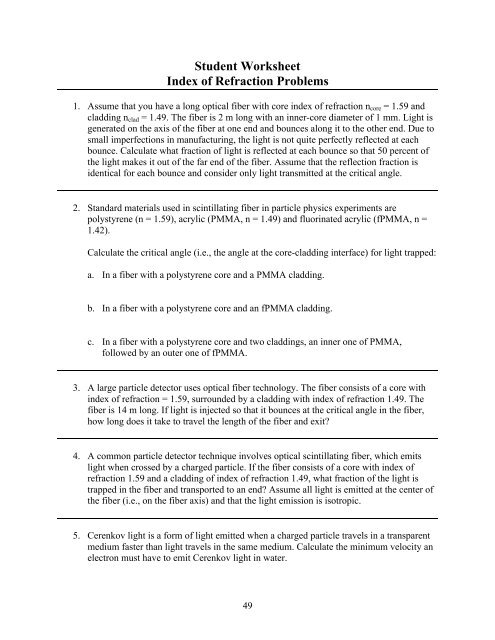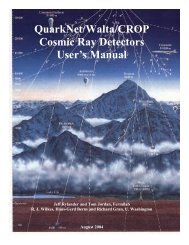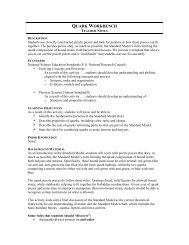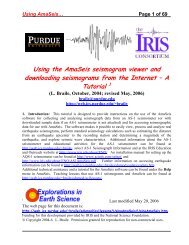Teaching Modern Physics - QuarkNet - Fermilab
Teaching Modern Physics - QuarkNet - Fermilab
Teaching Modern Physics - QuarkNet - Fermilab
Create successful ePaper yourself
Turn your PDF publications into a flip-book with our unique Google optimized e-Paper software.
Student Worksheet<br />
Index of Refraction Problems<br />
1. Assume that you have a long optical fiber with core index of refraction ncore = 1.59 and<br />
cladding nclad = 1.49. The fiber is 2 m long with an inner-core diameter of 1 mm. Light is<br />
generated on the axis of the fiber at one end and bounces along it to the other end. Due to<br />
small imperfections in manufacturing, the light is not quite perfectly reflected at each<br />
bounce. Calculate what fraction of light is reflected at each bounce so that 50 percent of<br />
the light makes it out of the far end of the fiber. Assume that the reflection fraction is<br />
identical for each bounce and consider only light transmitted at the critical angle.<br />
2. Standard materials used in scintillating fiber in particle physics experiments are<br />
polystyrene (n = 1.59), acrylic (PMMA, n = 1.49) and fluorinated acrylic (fPMMA, n =<br />
1.42).<br />
Calculate the critical angle (i.e., the angle at the core-cladding interface) for light trapped:<br />
a. In a fiber with a polystyrene core and a PMMA cladding.<br />
b. In a fiber with a polystyrene core and an fPMMA cladding.<br />
c. In a fiber with a polystyrene core and two claddings, an inner one of PMMA,<br />
followed by an outer one of fPMMA.<br />
3. A large particle detector uses optical fiber technology. The fiber consists of a core with<br />
index of refraction = 1.59, surrounded by a cladding with index of refraction 1.49. The<br />
fiber is 14 m long. If light is injected so that it bounces at the critical angle in the fiber,<br />
how long does it take to travel the length of the fiber and exit?<br />
4. A common particle detector technique involves optical scintillating fiber, which emits<br />
light when crossed by a charged particle. If the fiber consists of a core with index of<br />
refraction 1.59 and a cladding of index of refraction 1.49, what fraction of the light is<br />
trapped in the fiber and transported to an end? Assume all light is emitted at the center of<br />
the fiber (i.e., on the fiber axis) and that the light emission is isotropic.<br />
5. Cerenkov light is a form of light emitted when a charged particle travels in a transparent<br />
medium faster than light travels in the same medium. Calculate the minimum velocity an<br />
electron must have to emit Cerenkov light in water.<br />
49








